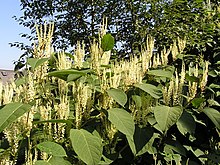Japanese knotweed
| Fallopia japonica | |
|---|---|
 |
|
| Scientific classification | |
| Kingdom: | Plantae |
| (unranked): | Angiosperms |
| (unranked): | Eudicots |
| (unranked): | Core eudicots |
| Order: | Caryophyllales |
| Family: | Polygonaceae |
| Genus: | Fallopia |
| Species: | F. japonica |
| Binomial name | |
|
Fallopia japonica (Houtt.) Ronse Decr. 1988 |
|
| Synonyms | |
|
Synonymy
|
|
Fallopia japonica, synonym Reynoutria japonica, commonly known as Asian knotweed or Japanese knotweed, is a large, herbaceous perennial plant of the knotweed and buckwheat family Polygonaceae. It is native to East Asia in Japan, China and Korea. In North America and Europe the species is very successful and has been classified as an invasive species in several countries. In Australia, it is illegal to have any of this species growing on one's property.
Japanese knotweed has hollow stems with distinct raised nodes that give it the appearance of bamboo, though it is not closely related. While stems may reach a maximum height of 3–4 m (9.8–13.1 ft) each growing season, it is typical to see much smaller plants in places where they sprout through cracks in the pavement or are repeatedly cut down. The leaves are broad oval with a truncated base, 7–14 cm (2.8–5.5 in) long and 5–12 cm (2.0–4.7 in) broad, with an entire margin. The flowers are small, cream or white, produced in erect racemes 6–15 cm (2.4–5.9 in) long in late summer and early autumn.
Closely related species include giant knotweed (Fallopia sachalinensis, syn. Polygonum sachalinense) and Russian vine (Fallopia baldschuanica, Polygonum baldschuanicum).
Other English names for Japanese knotweed include fleeceflower, Himalayan fleece vine, monkeyweed, monkey fungus, Hancock's curse, elephant ears, pea shooters, donkey rhubarb (although it is not a rhubarb), sally rhubarb, Japanese bamboo, American bamboo, and Mexican bamboo (though it is not a bamboo). In Chinese medicine, it is known as Huzhang (Chinese: 虎杖; pinyin: Hǔzhàng), which translates to "tiger stick". There are also regional names, and it is sometimes confused with sorrel. In Japanese, the name is itadori (虎杖, イタドリ?).
...
Wikipedia
